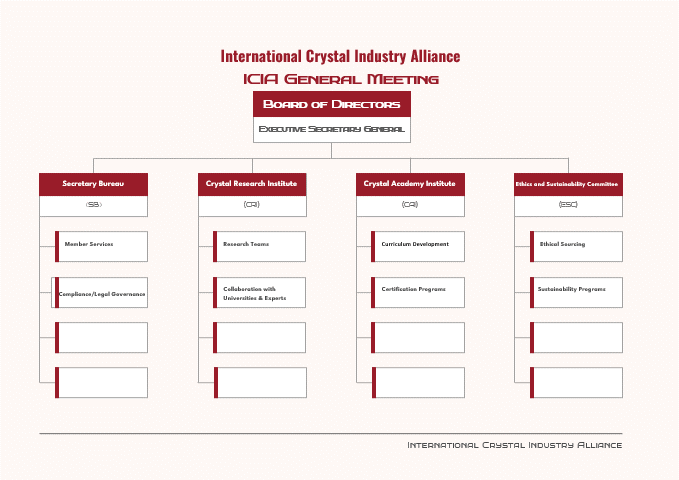International Crystal Industry Alliance (ICIA) Organizational Structure
The International Crystal Industry Alliance (ICIA) operates with a robust organizational structure designed to ensure global collaboration, effective governance, and the promotion of best practices across the crystal and mineral industries. The ICIA’s structure is built around functional divisions and committees, with a leadership team overseeing the strategic direction of the alliance.
General Meeting
- The highest authority: The General Assembly is usually the highest authority of the International Crystal Industry Federation and is composed of all members. Members can be enterprises, scientific research institutions, industry associations and other entities engaged in crystal industry-related business.
- Main functions: The General Assembly is responsible for deliberating and approving major matters of the Alliance, such as formulating and amending the Articles of Association to clarify the fundamental rules of the Alliance, such as the purpose, business scope, rights and obligations of members; Elect and dismiss members of the Council, and elect Council members who can represent the interests of members and have the ability to lead the development of the Alliance through democratic voting; Review the work report and financial report of the Alliance, supervise the overall operation of the Alliance and whether the use of funds is reasonable and compliant, and ensure that the operation of the Alliance meets the expectations of members and the development needs of the industry. Meetings are generally held on a regular basis, such as once a year, but in special cases, ad hoc meetings may be convened to deal with urgent and important matters.
1. Governing Body
At the core of ICIA’s governance is its Board of Directors, which provides high-level strategic direction and oversight.
Board of Directors
- Chairperson: Leads the board and oversees ICIA’s overall strategy and operations.
- Vice Chairperson: Supports the chairperson and may step in during their absence.
- Board Members: Industry leaders from key sectors of the crystal and mineral industry, including manufacturing, research, trade, and sustainability.
Supervisory board
- Supervisory Body: The Board of Supervisors is mainly responsible for the supervision function of the Alliance, and its members are generally elected by the General Assembly, which is independent and impartial, and aims to ensure that the operation and management process of the Alliance complies with laws and regulations, the Articles of Association and the interests of members.
- Scope of supervision: The Board of Supervisors is responsible for supervising the work of the Board of Directors and the management of the Alliance, checking whether there are any irregularities in their decision-making and implementation processes, and whether they have fulfilled their due duties; Supervise the financial status of the Alliance, review the authenticity and accuracy of financial reports, verify whether the financial income and expenditure are in compliance, and prevent financial fraud and other undesirable situations; Supervise the business activities of the Alliance, such as whether the exhibitions, training and other activities organized by the Alliance meet the predetermined goals and requirements, etc., to ensure the transparency and standardization of the Alliance’s operations and safeguard the rights and interests of all members.
2. Executive Leadership Team
The Executive Leadership Team ensures the day-to-day operations align with ICIA’s mission and strategic goals.
Executive Secretary General
- Oversees the operations of the entire organization, reporting to the Board of Directors.
- Manages coordination among divisions, ensuring alignment with global initiatives.
Division Heads
- Secretary Bureau (SB): Administrative support, governance, and member services.
- Crystal Research Institute (CRI): Research and scientific development in the crystal and mineral fields.
- Crystal Academy Institute (CAI): Educational programs, training, and certification.
- Ethics and Sustainability Committee (ESC): Ensuring ethical sourcing and sustainable practices within the industry.
3. Key Divisions and Committees
Crystal Research Institute (CRI)
- Focuses on innovation, sustainability, and scientific exploration of crystals and minerals.
- Research Teams: Work on material science, geology, and application research.
- Collaboration with Universities and Experts: Conduct global studies and share findings.
Crystal Academy Institute (CAI)
- Provides educational programs, certifications, and workshops for individuals and businesses in the crystal industry.
- Curriculum Development: Designs courses ranging from beginner to advanced levels.
- Certification Programs: Focuses on professional development and industry certifications.
Ethics and Sustainability Committee (ESC)
- Oversees the ethical standards and environmental sustainability within the crystal industry.
- Ethical Sourcing: Ensures conflict-free minerals and fair labor practices across the supply chain.
- Sustainability Programs: Advocates for eco-friendly mining, manufacturing, and recycling practices.
Secretary Bureau (SB)
- Provides administrative support, manages governance activities, and handles member services.
- Member Services Team: Onboards and supports members, providing resources and networking opportunities.
- Compliance and Governance: Ensures that the organization adheres to its policies, bylaws, and international laws.
4. Specialized Committees
In addition to the core divisions, ICIA operates specialized committees that oversee specific areas of focus:
- Legal and Compliance Committee: Ensures that all ICIA operations comply with international regulations and ethical guidelines.
- Membership and Networking Committee: Facilitates growth in ICIA’s global membership, fostering networking opportunities.
- Innovation and Technology Committee: Focuses on integrating technological advancements into the crystal industry, from processing to marketing.
5. Regional Offices
ICIA operates regional offices to cater to different geographic areas, ensuring that the alliance’s initiatives are relevant and tailored to local needs. These include:
- North America Office
- Europe Office
- Asia-Pacific Office
- Latin America Office
Each regional office works closely with local members and stakeholders to implement ICIA’s mission in a regionally appropriate context.
6. Membership and Outreach
ICIA offers membership at various levels, from individual professionals and researchers to large corporations and academic institutions. Membership benefits include access to:
- Educational Resources
- Industry Reports
- Networking Events
- Sustainability and Ethics Programs
7. Advisory Councils
Advisory Councils consist of experts from academia, industry, and the non-profit sector who provide strategic guidance on specific topics such as technology, innovation, and environmental impact.
Visual Representation of the ICIA Organizational Structure
